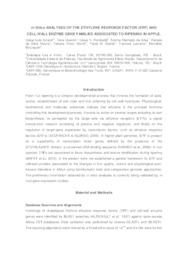In silico analyses of the ethylene response factor (ERF) and cell-wall enzyme gene families associated to ripening in apple.
In silico analyses of the ethylene response factor (ERF) and cell-wall enzyme gene families associated to ripening in apple.
Autoria: GIRARDI, C. L.; QUECINI, V.; ROMBALDI, C. V.; SILVA, N. M. da; MOURA, R. da S.; STORCH, T. T.; NOBILE, P. M.; LAURENS, F.; BOUZAYEN, M.
Resumo: Flesh fruit ripening is a complex developmental process that involves the formation of taste, aroma, establishment of skin color and fruit softening by cell wall hydrolysis. Physiological, biochemical and molecular evidences indicate that ethylene is the principal hormone controlling this developmental process. It exerts its action on several targets including its own biosynthesis, its perception by the target-cells via ethylene receptors (ETRs), a signal transduction network consisting of positive and negative regulators, and finally on the regulation of target-gene expression by transcription factors, such as ethylene response factors (ERFs) (STEPANOVA & ALONSO, 2009). In higher plant genomes, ERF is present as a superfamily of transcription factor genes defined by the presence of the APETALA2/ERF domain, a conserved DNA-binding sequence (NAKANO et al., 2006). In fruit species, ERFs are associated to flavor biosynthesis and texture modification during ripening (BAPAT et al., 2010). In the present work, we established a genetic framework for ERF and cell-wall proteins associated to the changes in fruit quality, texture and physiological post-harvest disorders in Malus using bioinformatic tools and comparative genomic approaches. The preliminary information obtained by in silico analyses is currently being validated by in vivo gene expression studies.
Ano de publicação: 2010
Tipo de publicação: Artigo em anais e proceedings
Unidade: Embrapa Uva e Vinho
Palavras-chave: Análise in silico, Etileno, Fruticultura, Genética, Maçã, Pós-colheita
Observações
1 - Por padrão são exibidas publicações dos últimos 20 anos. Para encontrar publicações mais antigas, configure o filtro ano de publicação, colocando o ano a partir do qual você deseja encontrar publicações. O filtro está na coluna da esquerda na busca acima.
2 - Para ler algumas publicações da Embrapa (apenas as que estão em formato ePub), é necessário ter, no celular ou computador, um desses softwares gratuitos. Sistemas Android: Google Play Livros; IOS: iBooks; Windows e Linux: software Calibre.
Acesse outras publicações
Acesse a Base de Dados da Pesquisa Agropecuária (BDPA) para consultar o acervo completo das bibliotecas da Embrapa.

